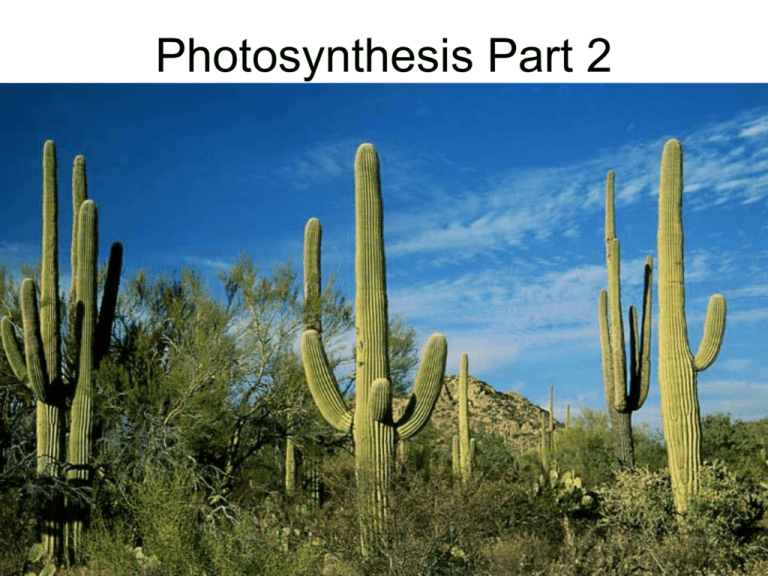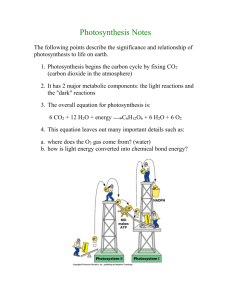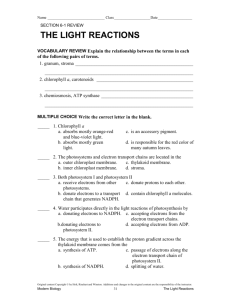Photosynthesis Part 2
advertisement

Photosynthesis Part 2 Chloroplasts • In green plants, photosynthesis occurs within organelles called chloroplasts. • Chloroplasts contain photosynthetic membranes arranged in flattened sacs called thylakoids which contain chlorophyll. • Thylakoids are arranged in stacks called grana. • The regions between the grana are called stroma. 2 Types of Photosynthetic Reactions The Light Reactions • Takes place in the presence of light (during the daylight hours). • Light supplies the energy for these reactions to occur. The Dark Reactions • These reactions occur without light (during the night). • However, the dark reactions depend upon the high energy chemical products produced during the light reactions. Light and Dark Reactions Overview The Light Reactions • Begin when chlorophyll in the thylakoids of the chloroplast absorb light. • The chlorophyll molecules in these thylakoid membranes are packaged into two photosytems. -Photosystem I -Photosytem II • Each photosystem contains hundreds of chlorophyll molecules. • Each chloroplast in a plant cell can contain millions of these photosystems! The Light Reactions and Photosystems • Photosystems I and II are linked together in structure and function. • When photosystem II absorbs light, electrons are passed to an electron transport chain. • This chain uses the electrons’ energy to make ATP. • At the end of the chain electrons are passed to photosystem I. • When photosystem I absorbs light, its electrons are passed to an electron carrier molecule NADP to make NADPH2 The Light Reactions and Photosytems • NADP is similar to the electron carrier NAD+ that we saw in cell respiration. • Photosystem II provides photosystem I with a continuous supply of electrons for these reactions. • When photosystem II absorbs light and loses electrons, it replaces the lost electrons by removing electrons from water (oxidizing water). • As a result Oxygen is produced. • Here you can see directly how water is necessary and oxygen is produced! The Light Reactions and Photosystems • In light, both photosystems absorb light at the same time. • Photosystem I uses absorbed light to generate NADPH2 by reducing NAD+ . • Photosystem II uses absorbed light to generate ATP via an electron transport chain. • These two high energy products, ATP and NADPH2 are used to power the remaining photosynthetic reactions – the dark reactions The Light Reactions and Photosystems Dark Reactions Dark Reactions and the Calvin Cycle • These dark reactions occur in the stroma of the chloroplast. • CO2 which diffuses into the stroma from the air outside is fixed, or used to make glucose. • The CO2 diffuses through tiny in pores in the leaf called stomates or stomata. • The incorporation of CO2 into an organic compound during photosynthesis is called Carbon fixation. • Carbon Fixation: Occurs through a series of enzyme controlled reactions called the Calvin Cycle. Calvin Cycle and Carbon Fixation • The starting and ending compound in the Calvin cycle is a 5-Carbon sugar called Ribulose Biphosphate or RuBP. • The cycle begins when CO2 reacts with RuBP producing 2 molecules of a 3 carbon compound called Phosphoglycerate or PGA. • ATP produced from photosystem II, and NADPH2 produced from photosytem I in the light reaction are used to convert each PGA molecule to a molecule of phosphoglyceraldehyde or PGAL (G3P) Calvin Cycle and Carbon Fixation • Most of the PGAL (G3P)is used to make more RuBP so the cycle can continue. • For every 6 molecules of CO2 that react in the cycle, 12 molecules of PGAL (G3P) are formed. • 10 of these PGAL (G3P) molecules are used to make RuBP while 2 PGAL (3 carbon) molecules react to form 1 glucose molecule (6 carbon) Calvin Cycle and Carbon Fixation







